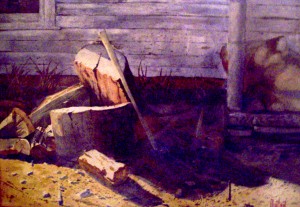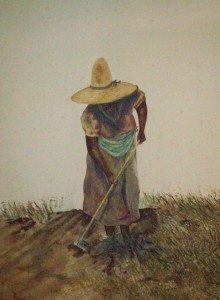
After many unhappy blunders behind me, I learned to fully appreciate the value of laying up a good wash with ease, confidence and speed. I highly recommend anyone with doubts in their abilities in this direction put off all other considerations until they acquire these skills. Laying up a good wash is the fundamental operation in watercolor painting.
The good news is that there are no great difficulties in laying a wash. You need to be careful, use common sense, and practice, practice, practice. Just a few hours of concentration on this single object will save weeks of misguided effort and will lay the foundation for technical efficiency.

Flat Wash
- Mix more required color in a saucer or bowl than you feel you need.
- Choose paper thick enough to accept the wash so it will not buckle or be uneven.
- Stretch the paper on a drawing board and secure.
- Tilt the board at approximately a 30 degree angle.
- Using a sponge absorbed with perfectly clean water, squeeze out about one-half of it, and pass the sponge lightly over the paper’s surface.
- Fill a large, wide, flat brush with the medium. When it is fully charged draw it with a long, light, steady and deliberate stroke across the top of the paper. Part of the color will wash down and form a pool at the bottom of the stroke.
- Charge the brush with medium again and make a second stroke overlapping the first one by about a half of an inch.

Gradated Wash (Takes a lot of practice–trust me!)
- Be sure to be aware of the opacity and transparency of the colors selected for use if using duel gradation technique.
- Smaller amount of color needed for gradated wash but make certain you have enough.
- Mix color selected.
- Make first stroke with the medium charged brush as mentioned above.
- After first stroke, very quickly, take a brush full of water (dilutes the color) and add it to the mixture for the second stroke.
- Proceed in this manner down the page–diluting the paint with more water with each stroke.
- Use as is–or use a duel gradation technique when dry, turn paper over and use a different color doing another gradated wash (this makes great moody skies in landscapes).

R.D.Burton: “Woman In The Field” (watercolor) Fun experiment and challenge for the wannabee artist.
- How to make a midday sky: Using the techniques described above, lay up a wash of very pale vermillion until it gradates to the white of the paper. Let it dry for 24 hours. After this, turn the paper upside down and repeat the gradated process washing it with a medium strength of cobalt blue to nothing.
- Creating an afterglow: Use same technique as above, but gradate a wash of cerulean blue over a fully dried gradation of yellow-orange mixture.
Be sure you are aware of opacity and transparency of colors especially when washing over one another.
Who (like me) doesn’t want to die as an unknown artist? If you’re interested in finding out more about becoming better known and selling your art work, click on the picture just above, R. D. Burton:”Woman in The Field.”
